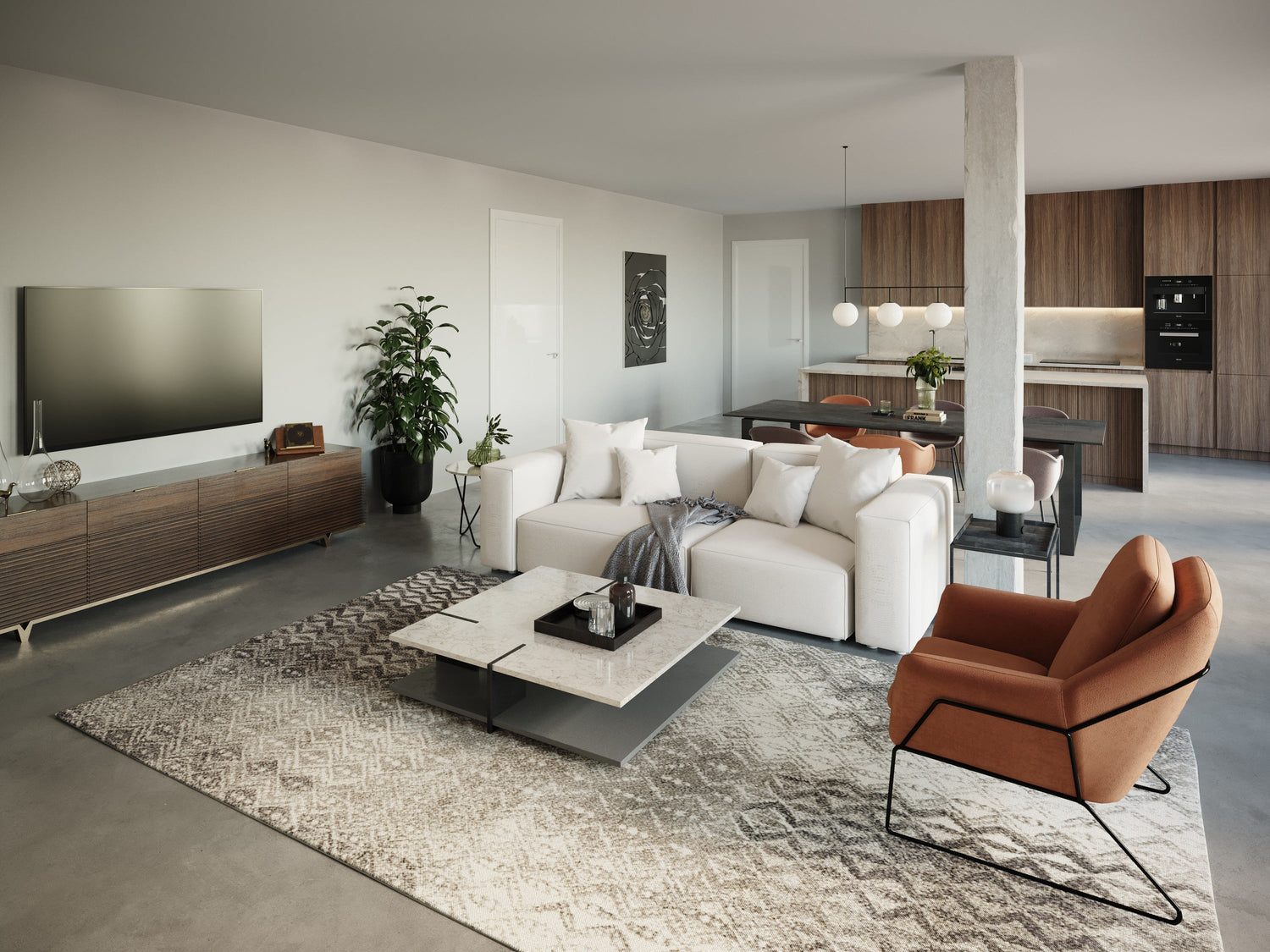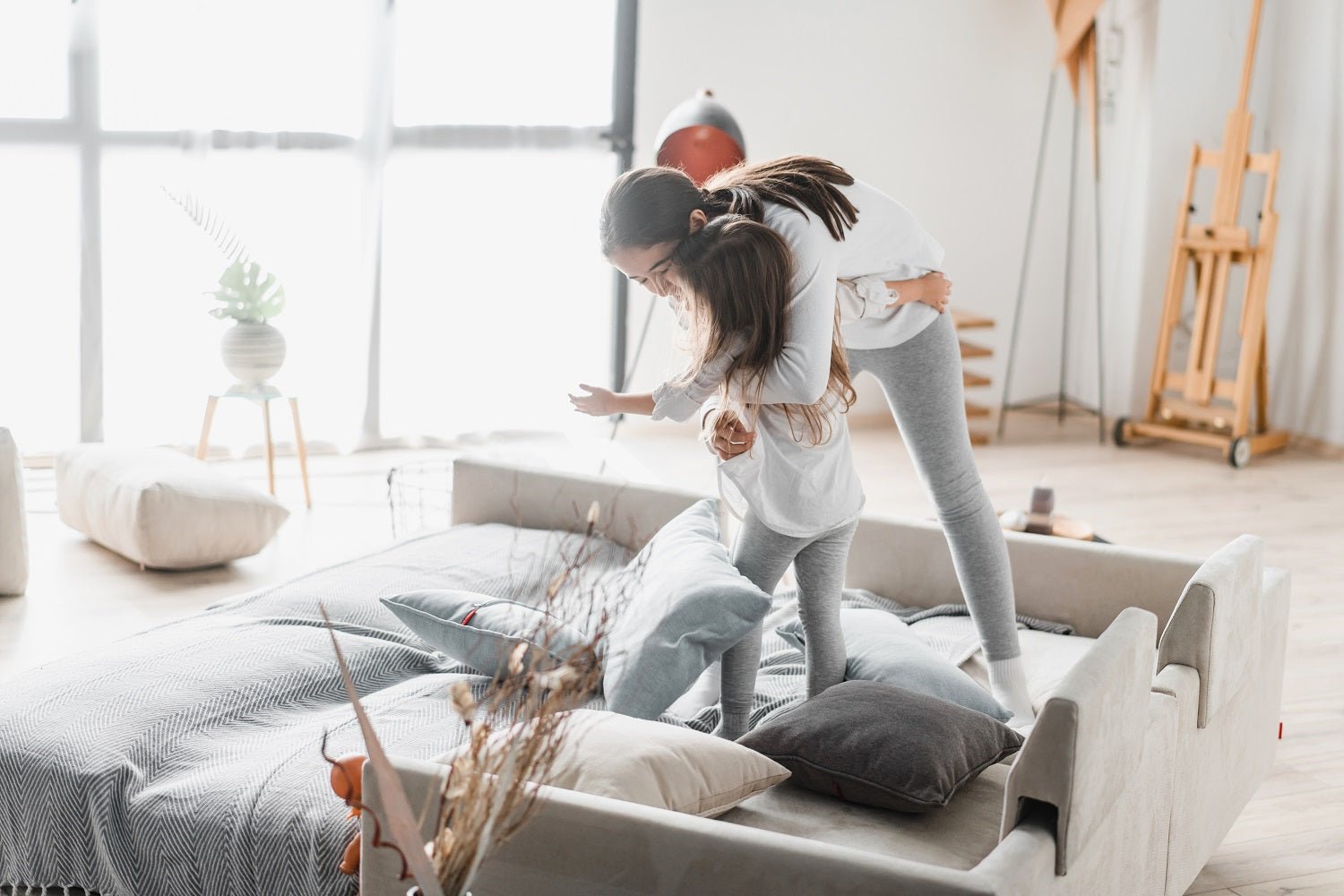Have you decided to renovate your living room and are you looking for new ideas to give it a fresh and modern touch? Choosing the right wall color plays a crucial role. In this article, we present ideas, trends, and tips to help you design your living room wall.
Why is the wall color in the living room so important?
Wall color has a significant impact on the atmosphere and mood of a room. In the living room, it's especially important to choose a color that invites you to relax and simultaneously reflects your personal style.
When it comes to living room design , wall color plays a crucial role. It can transform a room from a simple space into an inviting and cozy haven. Choosing the right color can influence the entire aesthetic and atmosphere of the room.
The wall color in the living room should not only be aesthetically pleasing but also support the room's function. Depending on how you use your living room, you can choose different colors to create the desired mood. For example, if you want to relax and calm down, soothing colors like blue or green are a good choice. However, if you prefer a lively and energetic atmosphere, you can choose warm colors like red or orange. When selecting the color, you should also ensure it complements the remaining furniture, such as sofas , coffee tables , or other decorations.
The psychological effect of colors
Colors have a direct influence on our feelings and emotions. Warm colors like red or orange, for example, can create a cozy and inviting atmosphere, while cooler colors like blue or green can have a calming effect.
The psychological effect of colors has long been studied and used. It's known that certain colors can trigger specific emotions. Red is often associated with energy and passion, while blue represents calmness and serenity. Yellow can convey joy and optimism, while green can have a calming and refreshing effect.
When choosing a wall color for your living room, it's important to consider the desired mood and atmosphere. Do you want to create a room that invites you to relax and unwind? Then soft and soothing colors like pastel blue or lavender might be the right choice. On the other hand, if you want to design a room that radiates energy and vitality, you might choose stronger colors like sunny yellow or bright red.
How colors influence the perception of space
Choosing your wall color can also influence your spatial perception. Bright colors make a room feel larger and more open, while darker colors can create a more comfortable and intimate atmosphere. Therefore, it's important to consider the size and shape of the room when choosing a wall color.
If you have a small living room, you can visually enlarge it with light colors like white or pastels. Due to the reflective properties of these colors, the light is better distributed throughout the room, making it appear airier and more spacious. However, if you have a large living room and want to create a more comfortable atmosphere, you can work with dark colors like dark gray or brown. These colors absorb the light and make the room feel more intimate and inviting.
Space perception can also be influenced by the use of color combinations. By combining different colors on the walls, you can highlight or visually connect certain areas in the room. For example, painting one wall in a strong color can create an eye-catcher, or using contrasting colors can define different areas in the room.
Top 10 ideas for wall colors in the living room
Classic color elections
If you prefer a timeless and elegant look, classic colors like beige, gray, or white are a good choice. These neutrals provide a versatile base that can easily be combined with various furnishings and decor.
Beige is a warm and soothing color that gives your living room a cozy atmosphere. It's an excellent choice for rooms where you want to relax and unwind. Gray, on the other hand, is a versatile color that can be cool, modern, or warm and inviting, depending on the shade. White is a timeless and elegant color that gives your living room a light and airy feel. To emphasize the light wall colors, a sofa in a light fabric, such as Snoer Nata , Taupe, or Truffle, is suitable.
Brave and modern color ideas
For a vibrant and individual look, choose strong colors like yellow, red, or blue. These shades give your living room a modern and fresh look and offer an exciting contrast with neutral furniture and accessories.
Yellow is a happy and energetic color that gives your living room a sunny and inviting atmosphere. It's a great choice for brightening a room and creating a positive mood. Red, on the other hand, is a passionate and powerful color that gives your living room a warm and inviting atmosphere. It can be used as an accent color to highlight certain areas or as a wall color for a dramatic effect. Blue is a calming and relaxing color that gives your living room a peaceful and tranquil atmosphere. It's an ideal choice for rooms where you want to unwind and switch off.
Current trends in wall color design
Natural and earthy colours
A current trend in living room wall colors is natural and earthy tones like brown, green, or terracotta. These colors create a warm and cozy atmosphere and make the room feel close to nature.
The use of brown in wall design can encompass various shades, from soft beige to deep chocolate brown. This color lends a certain elegance to the room and complements rustic or classic interior styles well.

Green, on the other hand, symbolizes nature and brings freshness to a room. Various green tones can be used for wall design, such as a soft mint green or a vibrant forest green. This color has a calming effect and can create a relaxing atmosphere.

Terracotta is a warm, earthy reddish-brown reminiscent of Mediterranean landscapes. It gives the room a rustic and cozy tone. Terracotta colors combine well with neutrals like cream or gray to create a harmonious overall look.
Mystical black
It certainly takes some courage to choose black as a wall color. But if you take the risk, you'll be rewarded. Even a single wall can give a room a completely new atmosphere. In the living room, this deep color fulfills several functions: its calming, non-tonal character allows the eyes to relax, provides a neutral base for all kinds of colors and patterns, and gives the room a modern touch. Textiles in soft colors, such as pink, provide a bright spot in the dark. Black exudes confidence and can simultaneously create a cozy atmosphere. Because dark tones make walls seem closer and envelop us like a warm blanket.
Vibrant and strong colours
On the other hand, vibrant and strong colors like pink, turquoise, or violet are also trendy. These shades give your living room a lively and energetic note and set interesting accents.
Pink is a strong and striking color that instantly makes a room a focal point. It can be used as a wall color to create a room with personality and individuality. Pink combines well with neutrals like white or gray to create a balanced contrast.
Turquoise is a refreshing and vibrant color reminiscent of tropical waters. It can bring a certain lightness to a room and create a relaxing atmosphere. Turquoise combines well with other shades of blue or with white to create a nautical flair.
Violet is an elegant and mysterious color that adds depth to a room. There are various shades of violet, from soft lavender to deep aubergine. Violet combines well with other colors like gray or beige to create a harmonious overall look.
Choosing a wall color plays a crucial role in the design of your living room. Whether it's natural, earthy tones or vibrant, bold colors, the most important thing is that the colors match your personal style and the desired atmosphere. Be creative and design your living room exactly as you envision it!
Practical tips for choosing the right wall color
Consideration of light and room size
Before choosing a wall color, consider the natural lighting in your living room. Bright colors reflect light and make the room appear larger, while dark colors absorb light and make the room feel more comfortable.
The lighting in a room can vary depending on the time of day and the weather. If your living room gets a lot of daylight, you might consider using brighter colors to make the room more vibrant and energetic. However, if your living room is rather dark, you should choose lighter colors to brighten the room and create a more welcoming atmosphere.
The size of the room also plays an important role in choosing a wall color. In a smaller room, bright colors can help visually enlarge the space and create an airy atmosphere. Darker colors can be used in larger rooms to create a more comfortable and intimate atmosphere.
Coordinating the wall color with furniture and decor
It's important to match the wall color to your furniture and decor. Choose colors that complement existing colors and create a harmonious overall effect. Test different color patterns on the wall to ensure the color complements your living room.
For example, if you have a neutral color palette for your furniture, you can add accents with a bolder wall color and give the room more personality. However, if your furniture already has bold colors, you should choose a wall color that complements those colors, not competes with them.

Remember that the wall color should also match the room's decorations, such as the pillows or rug . For example, if you have artwork on the walls, choose a wall paint that highlights the artwork and makes it the focal point of the room.
How to apply wall color to your living room yourself
Preparing the walls
Before applying wall paint, it's important to thoroughly prepare the walls. Remove any old wallpaper or paint, thoroughly clean the surface, and repair any cracks or bumps.
It's advisable to prime the walls before painting to ensure better color adhesion. A primer creates an even surface and prevents uneven application. Choose a primer that matches your wall quality and desired color.
Application techniques for a professional look
You can use various application techniques for a professional result. Use a paint roller for straight surfaces and a brush for corners and edges. Apply the paint in even, controlled strokes and allow it to dry thoroughly.
If you want a decorative effect, you can also use various techniques, such as sponge, DAB, or wiping. These techniques give your wall an interesting pattern or texture and give your living room a unique look.
Applying the right amount of color is also important. Too little color can lead to uneven results, while too much can bleed and create dirty edges. Make sure you distribute the color evenly and blot away any excess to achieve a clean finish.
After applying the first coat of paint, let it dry thoroughly before applying a second coat. A second coat will provide better coverage and a more even look.
With these tips, you can give your living room a new look and create a space that reflects your personal style. Experiment with different colors and techniques, and have fun designing your living room!


